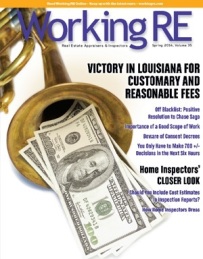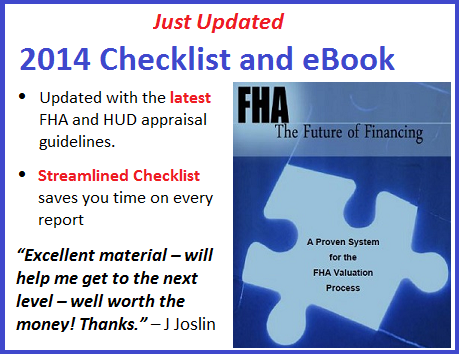 |
>> See Past News Editions >> Click to Print >> Upcoming Two-Part Webinar Series >> Slow? Get Busy: Work directly with clients, bypass AMCs, get paid full-fees and diversify your business. Click here to learn more. |
Editor’s Note: A handful of appraisal management companies (AMC) have contacted Working RE/OREP over the last few months requesting data from our Customary and Reasonable Fee Survey- which leaves us wondering why.
Customary and Reasonable Fee Data Revisited
by David Brauner, Editor
It may be time to take a stroll down memory lane. What were considered fair fees prior to the Home Valuation Code of Conduct (HVCC)? Why does it matter?
Whether you are among those who believe the concept of C&R Fees is impossible to implement or those who think the idea is ill-advised even if it was possible, the fact remains it is written into the law as per Dodd Frank and lenders are responsible for seeing that it is followed. Here’s a quick summary.
Everything changed for appraisers with HVCC in May, 2009. In July 2010, Dodd-Frank was passed, codifying the concept of Customary and Reasonable Fees, though it was later “neutered” by the Interim Final Rule which followed about three months later.
As of today, nearly four years after Dodd Frank, the issue of C&R Fees is not settled. Late last year the lead enforcement attorney for the Consumer Financial Protection Bureau (CFPB), Anthony Romano, told an appraiser conference that the issue is important to the agency and is on its agenda for 2014. Then, when pressed for details in a follow up interview with WRE, Romano remained mum.
Growing impatient, a handful of states, Louisiana being the most notable, found a way to make it work, serving as a model for appraisers in other states.
(story continues below)

(story continues)
What are C&R Fees?
In August 2010, OREP/Working RE launched a nationwide Customary and Reasonable Fee Survey. Over 17,600 appraisers participated. The results, broken down by location and type of report, are like looking at an old photo which serves as evidence of a time and a place and the way things were, despite our current memory and the passing of time and the changing of circumstance. Folks, the results of this survey are a snapshot of life prior to HVCC, without AMCs.
The Survey is predicated on the idea that prior to HVCC, when appraisers and clients negotiated fees directly without a middleman, there was a general agreement about what a fair fee was for a certain type of appraisal report in a given location. Not an exact number but a fee within a fairly narrow range. Some earned more, some a little less but most appraisers and lenders knew about what was customary and reasonable in their area. You’ll find that the results of the Survey support this notion as most responses cluster within a fairly narrow range, indicating broad agreement.
The Survey is broken out by 365 Metropolitan Statistical Ares (MSA) as defined by the U.S. Census Bureau and includes rural areas by region. It includes six (6) different appraisal products including reviews. It also surveys turnaround time, which many appraisers say is the biggest obstacle to quality, worse even than low fees. It might be interesting to compare the results then to what you experience today; has turn-time pressure diminished since 2010 or is it as bad as ever?
The Survey assumes assignments that are not complex and focuses on full fee, non-AMC work, even though many appraisers today are willing accept a discounted fee from an AMC as a trade off for services provided, such as marketing, collection, review, etc. Note that the survey data is prior to the Uniform Appraisal Dataset (UAD), which adds a level of complexity to appraising. And, of course, the fees are not adjusted for inflation.
(story continues below)

(story continues)
Modern Times
As we write this, we know fees are depressed again after a brief respite because things have slowed. But this won’t always be the case. The best advice we’ve heard over the years is for appraisers to do good work and charge a fair fee for it. With appraisal reports becoming more complex and time consuming, thanks to the UAD, with ever-increasing stips from closer lender scrutiny and the added pressure of Fannie Mae’s new “blacklist,” charging a fee which allows you to take the time necessary to do a thorough and careful report is not just important any longer but vital to survival.
If you want to refresh your memory about what you said were fair fees in your area back before the market turned upside down, you can revisit the survey results here, for free of course: https://www.workingre.com/customary-and-reasonable-fees-survey-results/
Two-Part Fannie Mae “Blacklisting” Webinar Series with Richard Hagar
“I took the Blacklisting webinar today and was not prepared for that information. I just took 28 hours of education the past 2 months, several of which were courses on the latest issues, the newest UAD developments, etc. None of the courses mentioned any of this. This is going to turn this profession upside down, and I bet a lot of appraisers will quit when they start having problems. That webinar on blacklisting this morning is the biggest surprise I’ve had in a long time. It’s very disturbing.” -V. Rose
Part 1: UPDATED – Keeping Off Fannie Mae’s New Appraiser “Blacklist”
Available Now – Watch at Your Convenience
Hagar shares the latest on Fannie’s new rules including how its blacklist works, how Fannie Mae will be evaluating appraisers going forward, and what appraisers can do to stay out of trouble.
Part 2: Fannie Mae’s AQM and How to Stay Out of Trouble
May 8th, 10 – 11:15 PDT
Hagar shows you specifics on how to make the “correct” UAD choices to avoid “hard stops,” “fatal warnings” and “critical messages” and keep you in business.
**All webinars are recorded and available at no charge with paid attendance.
>>Check out Agent’s Edition
We’re always listening: Send your story submission/idea to the Editor: dbrauner@orep.org.


by KR
C & R Fees is a long standing Joke to keep “daydreaming” appraisers HOPING something will get corrected meanwhile the Banks & their AMC’s are getting Richer while putting Appraisers out of Business! Stop daydreaming & walk away
-by Free Speech
The whole concept of “customary and reasonable fees” is nothing but socialism. Everything going on now is designed to destroy the appraisal occupation. The state agencies are nothing but tools of the lending industry to keep appraisers afraid and under control. The joke has already been told and it’s on us.
-by Garth27
If fees went up over the past year, they cannot possibly go back down due to lack of demand. Even the Interim Final Rule says that fees paid in the last year can be used to base fees now. the other option is to pay the same fees as non-AMC work (VA Fees). They can’t have it both ways. Any AMC that is lowering fees is violating the law and subject to the $10,000 fine per order. I can’t wait until law enforcement starts enforcing this law . . . oh wait. . no one cares.
I know most conservatives think that they are supposed to be against unions, but that is not true. What conservatives are against are government mandated unions. We believe in “Right to Work” where a person has a choice to join. Unions have done great things in the past, but became too powerful and corrupt, mostly due to the lack of incentive to attract workers because it was required.
Appraisers cannot rely on lawyers, politicians, Appraisal associations or even USPAP. None of them have done much for us in the past few years. USPAP has become a joke putting in requirements that have no place in appraising. We need to join a union and use our power as a group to demand reasonable fees, reasonable rules and reasonable treatment.
Like many of you, I have pretty much given up.I have joined a union as a last resort. If this does not work, nothing else will.
-by Pat Bange
C and R fees or unnecessary. Take the appraiser OUT of the AMCs profit. Banks should be paying the AMCs for their services apart from the appraisal. That would take care of a lot of the problems which now are killing the appraisal profession. Solution is so SIMPLE
-by Alan Gertner
The GSE’s (Fannie Mae and Freddie Mac) require appraisals to be submitted to the UCDP web site and to pass the UCDP XML validation test. Since passing the UCDP XML validation test is a requirement, the UCDP XML validation test MUST be publicly available to the Appraisal User Community for testing. This would allow the entire Appraisal User Community to confirm an appraisal report will pass the UCDP XML validation test BEFORE submitting the appraisal to the UCDP web site. This would also allow the appraisal software vendors to test their appraisal software to confirm it complies with the UCDP requirements. This is an ongoing problem which will not go away.
The GSE’s have already setup a similar public testing web site for the Loan Origination XML files at:
https://www.fanniemae.com/singlefamily/loan-delivery-test-environment
The GSE’s need to provide a similar public test environment for the UCDP Appraisal Reports.
The GSE’s currently limit their support and UCDP validation test access to a small group of privileged vendors. The GSE’s deny access to the rest of the Appraisal User Community.
The Appraisal User Community has already requested the GSE’s provide the UCDP public test web site. The GSE’s refuse to do so.
-